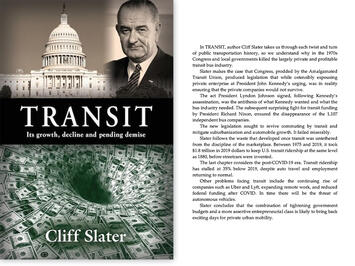
Who said the following? “The basic objective of our Nation’s transportation system must be to assure the availability of the fast, safe, and economical transportation services needed in a growing and changing economy. . . . This basic objective can and must be achieved primarily by continued reliance on unsubsidized privately owned facilities, operating under the incentives of private profit and the checks of competition to the maximum extent practicable. . . . This means . . . equality of opportunity for all forms of transportation and their users and undue preference to none. It means greater reliance on the forces of competition and less reliance on the restraints of regulation. And it means that, to the extent possible, the users of transportation services should bear the full costs of the services they use, whether those services are provided privately or publicly.”
- Ronald Reagan;
- Milton Friedman;
- Ayn Rand; or
- The Antiplanner?
In fact, the answer is 5. John F. Kennedy. Or at least this statement was contained in Kennedy’s April 2, 1962 message to Congress on having an “efficient transportation system.” This means it was probably written by staffers in the Department of Commerce, as the Department of Transportation did not yet exist. Whoever wrote it was at least willing to talk the talk of free markets and fiscal conservatism.
I was alerted to this quote when I read page 147 of Cliff Slater’s new (released December 15, 2023) book on urban transit. I’ve known Slater for many years and when I learned he was writing a book on transit at about the same time my book, Romance of the Rails, was being released, I worried that the two would duplicate one another. Instead, it appears that the two complement one another, as the history he tells is quite different from mine, not because of any disagreements between us but because there is so much history that neither of us could cover it all in a single book.
An example is part IV (pp. 135-214), his detailed story of the passage of the Urban Mass Transportation Act of 1964. Even as some nameless bureaucrat was drafting the above words, Slater shows that political forces consisting of big-city mayors, downtown property owners, private railroads interested in staunching their losses from running commuter trains, and government-owned transit agencies were working to undermine it.
At the time, there were about 1,100 private bus companies providing transit services in cities and towns all over the country (p. 148). In 1963, the transit industry as a whole lost about $4 million, but a handful of government-owned rail transit agencies in New York, Boston, San Francisco, and a few other cities collectively lost at least $41 million (pp. 166-167). That means the 1,100 private bus companies must have collectively made at least $37 million in profits (about $450 million in today’s dollars). In fact, their profits were even greater as Slater wasn’t able to document the losses from rail transit systems in El Paso, New Orleans, Philadelphia, Pittsburgh, and St. Louis.
Despite this, proposals to “save transit” in the early 1960s completely ignored the interests of these bus companies. At a meeting of mayors, city officials, and rail transit agencies, the American Transit Association (forerunner of today’s American Public Transportation Association) agreed with the others that any federal funds for transit should not go to private transit operators (p. 147). Their reasoning was simple: most private bus companies were not members of ATA, and since it assessed its membership fees based on the size of the company or agency, it received most of its revenues from the money-losing rail transit agencies, not the few profitable private companies that had bothered to join (many of which quit when it learned that ATA was supporting legislation that would favor public agencies over them — p. 148).
One of the great things about Slater’s book is that his associated web site has all of his footnotes with links to the original sources whenever possible. I downloaded the Congressional Record from which the president’s statement quote above was taken and found that even that statement proposed to discriminate against private operators, indicating the authors talked the free-enterprise talk but didn’t walk the free-enterprise walk.
The statement observed that urban transportation patterns had changed with both people and jobs moving to the suburbs. It further admitted that urban transit agencies had failed to adjust to this change and “remained geared to the older patterns.” It didn’t mention that the private bus companies were adjusting, as many were serving suburban areas, but it was the rail transit agencies that remained stuck with their downtown-centric systems.
Read the rest of this piece at The Antiplanner.
Randal O'Toole, the Antiplanner, is a policy analyst with nearly 50 years of experience reviewing transportation and land-use plans and the author of The Best-Laid Plans: How Government Planning Harms Your Quality of Life, Your Pocketbook, and Your Future.
Cover photo: Courtesy, Cliff Slater. Find the best price on this book at Bookfinder.com












